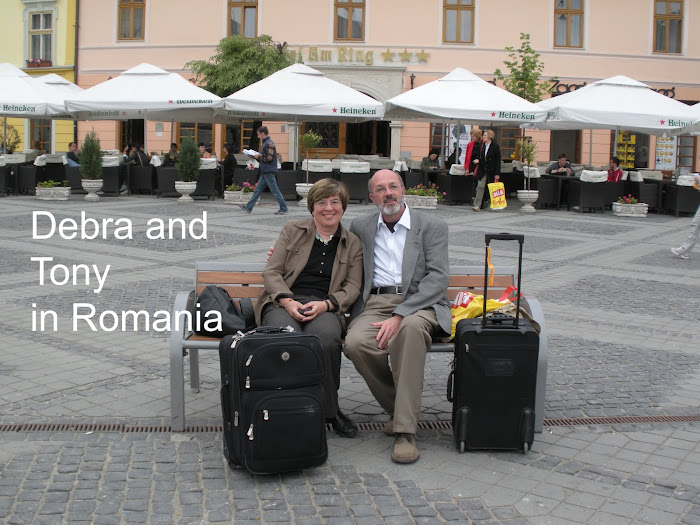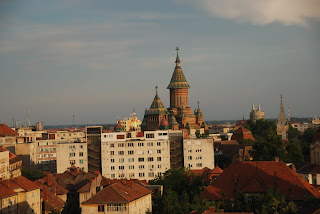This is my last Romanian post; tomorrow we sadly head home. Thanks to everyone--especially our Romanian friends from Timisoara, Sibiu, and Bucharest--for making these 5 months so terrific.
Tuesday, June 30, 2009
Saturday, June 27, 2009
My little corner of the world

Souvenirs and keepsakes that are lined up on my dresser--all reminding me of the wonderful places I have seen in these glorious five months.
Legend:
The Back Row (from left to right):
Picture of my mother(on one of her great adventures in Greece).
Blue and white wooden egg cup from Sibiu Village Museum.
White ashtray from the Meridien in Budapest (it says "To cease smoking is the easiet thing I ever did. I ought to know. I've done it a thousand times." Mark Twain. A most apt European souvenir). Sitting in the ashtray is a kind of Easter egg bought in the Timisoara Easter Market and two little black marbles from a Krakow restaurant).
A little wooden jewelry box, also bought in the Timisoara Easter Market.
A mug showing an old version of the Penguin fiction series (this one is Persuasion), bought in London.
In front of the picture:
A little stone that says "Home" bought at Edenside Gallery in Louisville,
A little pottery colander, bought at the Village Museum in Sibiu,
A little glass decorated box bought in Ravenna.
In front of the eggcup:
Terracotta figure of a cherub, bought in Venice,
A little handpainted bowl from Budapest.
In front of the ashtray:
Charles Rennie Mackintosh (seccesionist!) reproduction box from Edinburgh,
A colored tile bought in the Budapest Easter Market.
In front of the jewelry box:
A shard from the Fabric Synagogue in Timisoara, found in the street,
Painted box from the Timisoara Easter Market.
Wednesday, June 24, 2009
Wednesday, June 17, 2009
Tuesday, June 16, 2009
Hives
 When we were in Budapest, we visited Odon Lechner's Postal Savings Bank. It's decorated by (among other fanciful creatures), large beehives to which ants (see below) are crawling upwards.
When we were in Budapest, we visited Odon Lechner's Postal Savings Bank. It's decorated by (among other fanciful creatures), large beehives to which ants (see below) are crawling upwards.
The hive, we read, is a symbol of the sweetness that is achieved by saving, and hence its presence signals the building is a bank.
 Then we started noticing hives on buildings in Timisoara, like this one on the Banca de Scont right off Piata Unirii.
Then we started noticing hives on buildings in Timisoara, like this one on the Banca de Scont right off Piata Unirii.
And this one on what was originally the Iosefin Savings Bank.

This is on a building in Piata Stantul Gheorge.
 This figure, though, we don't get. Hives as headress. She's on a large building in Fabric that has a big boat coming out of the pediment and that seems to be a collection of apartments. I would love to know what her iconography means. I also wish I knew how to "read" the other images I see so often on these Timisoara buildings --how many are fanciful and how many signal something about how the building was to be used or understood as a civic space.
This figure, though, we don't get. Hives as headress. She's on a large building in Fabric that has a big boat coming out of the pediment and that seems to be a collection of apartments. I would love to know what her iconography means. I also wish I knew how to "read" the other images I see so often on these Timisoara buildings --how many are fanciful and how many signal something about how the building was to be used or understood as a civic space.Casa cu Pauni: FTB 4

The Case cu Pauni (Peacock House) is the first building I saw in Timisoara that I realized was something special. I had found it via the Blue Guide (during my first real walk), where I read that it was designed by Martin Gemienhardt, one of Timisoara's leading Seccesionist architects.
 I kept coming back to these buildings and discovering how alive they are.
I kept coming back to these buildings and discovering how alive they are. Images of animals and birds and plants everywhere.
Images of animals and birds and plants everywhere.
Even here (under the cornice), where you can hardly see it, unless you look.
 Even the door has these organic, curvy, peacock-looking lines.
Even the door has these organic, curvy, peacock-looking lines.
I figured I would find out all about Martin Gemeinhardt, but even after extensive (mainly internet) searches, I have discovered almost nothing at all, except that 1) he signed these buildings; 2) he designed another building (kind of Gothic revival but also with lots of organic details) on what is now Blvd 16 Decembrie 1989; 3) that he has some connection with the Anchor House in Iosefin; 4) and that he and his father belonged to a music society in Timisoara.
Saturday, June 13, 2009
Back to the beginning
 This is Bologna. One of the many arcades that connect the city. This one has 666 arches and leads to a shrine right outside the city.
This is Bologna. One of the many arcades that connect the city. This one has 666 arches and leads to a shrine right outside the city.Back from Britain
 The Scott Monument.
The Scott Monument. Ascending the Scott Monument.
Ascending the Scott Monument.Tuesday, June 2, 2009
Oradea 3: The Black Eagle
 When we were in Oradea, we stayed at the Black Eagle, a commercial center in the main square. It was designed by Komor and Jakab and was, according to Frederic Bedoire and Robert Tanner, "the most extensive effort to give Nagyvarad [Oradea] the appearance of a big city, with an elegant glazed arcade, inspired by the Gresham in Budapest." They also argue that its size and color made it the "riposte of Jewish enterprise to the three Christian churches which until then had dominated the [main square]."
When we were in Oradea, we stayed at the Black Eagle, a commercial center in the main square. It was designed by Komor and Jakab and was, according to Frederic Bedoire and Robert Tanner, "the most extensive effort to give Nagyvarad [Oradea] the appearance of a big city, with an elegant glazed arcade, inspired by the Gresham in Budapest." They also argue that its size and color made it the "riposte of Jewish enterprise to the three Christian churches which until then had dominated the [main square]." From the only stained glass window that survived.
From the only stained glass window that survived. The hotel bursts with all kinds of intricate details. (This one is actually the top of a gutter).
The hotel bursts with all kinds of intricate details. (This one is actually the top of a gutter).
(Tony said it felt a little like staying in a cupcake, but that's another story.)
 .
.It was an extraordinary experience, after seeing all those buildings, to be able to stay in one.

Komor and Jakab also designed two houses for Emil Adorjan, the Jewish entrepreneur who commissioned and financed the Black Eagle. Bedoire and Tanner use Oradea as one of their examples of the "New Jersusalem," and explain how the identity of Oradea's Jewish community was manifested as much, if not more, in the civic landscape of the city as it was in synagogues.
 According to Bedoire and Tanner, Adorjan was "a man of about thirty, entrepreneur as well as intellectual, in close touch with the financial world and with the radical writers in the city, and a great collector of books."
According to Bedoire and Tanner, Adorjan was "a man of about thirty, entrepreneur as well as intellectual, in close touch with the financial world and with the radical writers in the city, and a great collector of books." Like Komor, Adjoran died in the Holocaust. Oradea became, next to Budapest, Hungary's largest ghetto; of the 27,000 Jews deported in 1944, Adjoran was the first to go.































